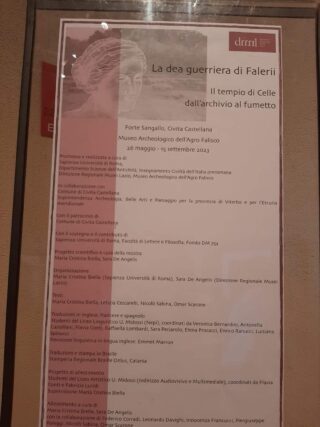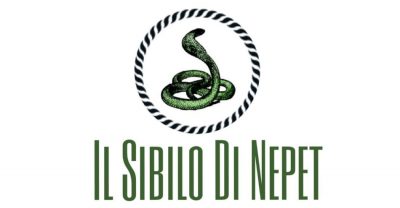 Il progetto PCTO « La dea guerriera di Falerii. Il tempio di Celle dall’archivio al fumetto » è stato svolto dalla nostra scuola in collaborazione con l’Università “la Sapienza” di Roma. Il lavoro è consistito nell’organizzare una mostra dall’inizio alla fine, senza tralasciare nessun dettaglio.
Il progetto PCTO « La dea guerriera di Falerii. Il tempio di Celle dall’archivio al fumetto » è stato svolto dalla nostra scuola in collaborazione con l’Università “la Sapienza” di Roma. Il lavoro è consistito nell’organizzare una mostra dall’inizio alla fine, senza tralasciare nessun dettaglio.
L’attività ha coinvolto tutti gli indirizzi dell’Istituto Midossi, ognuno dei quali ha collaborato in base alle  proprie competenze specifiche. Noi del liceo linguistico abbiamo tradotto i pannelli della mostra nelle lingue che studiamo per consentirne la comprensione ad un pubblico sempre più vasto. Siamo anche stati le guide dei visitatori presenti nel giorno dell’inaugurazione, ognuno nella lingua che gli era stata assegnata.
proprie competenze specifiche. Noi del liceo linguistico abbiamo tradotto i pannelli della mostra nelle lingue che studiamo per consentirne la comprensione ad un pubblico sempre più vasto. Siamo anche stati le guide dei visitatori presenti nel giorno dell’inaugurazione, ognuno nella lingua che gli era stata assegnata.
L’inaugurazione della mostra, che resterà aperta fino al 15 settembre, si è tenuta lo scorso venerdì 26 maggio al Museo Archeologico dell’Agro Falisco nel Forte Sangallo, un luogo storico e iconico di Civita Castellana.
C’è stata una grande affluenza di visitatori di ogni età, dai più piccoli ai più grandi! Per noi studenti questa è stata un’esperienza entusiasmante e anche un primo approccio al mondo del lavoro.
Ecco, di seguito, due testimonianze di chi quell’esperienza l’ha vissuta.
Au cours de cette troisième année d’études, j’ai franchi la première étape de mon parcours d’orientation scolaire et professionnelle (PCTO) en participant au projet « La dea guerriera di Falerii. Il tempio di Celle dall’archivio al fumetto » qui est né de la collaboration entre l’établissement d’enseignement secondaire “Midossi” et l’Université de Rome “La Sapienza”. Une équipe d’archéologues, coordonnée par la chercheuse Maria Cristina Biella, nous a guidés à travers le processus d’élaboration progressive d’une exposition consacrée au temple de Celle, lieu de culte de Junon dans l’ancienne cité de Faléries Veteres, aujourd’hui nommée Civita Castellana. Les élèves concernés ont contribué au projet selon leur filière d’appartenance. En tant qu’élèves du lycée linguistique, mes copains et moi, nous avons d’abord été chargés de traduire les panneaux de l’exposition vers les langues étrangères que nous étudions. Ensuite, huit lycéens, dont moi-même, ont joué le rôle de guides lors de l’inauguration de l’exposition qui a eu lieu le 26 mai à l’intérieur du Forte Sangallo, la forteresse qui abrite le musée archéologique de Civita Castellana.
J’ai été heureux de présenter aux nombreux visiteurs le fondateur mythique de Faléries Veteres, Halésus, qui, selon une interprétation récente, était représenté dans le temple de Celle en train d’enlever une jeune nymphe.
C’était qui Halésus ? C’était un héros grec, originaire d’Argos, un des nombreux héros qui, selon la tradition, a erré longtemps après la Guerre de Troie. C’était, peut-être, le fils ou le compagnon d’armes du très puissant Agamemnon, conquérant de Troie, la ville que les Romains avaient choisie pour représenter et ennoblir leurs origines à travers le mythe d’Énée.
La légende raconte qu’après le meurtre d’Agamemnon par Clytemnestre, il traversa la Méditerranée jusqu’à atteindre l’Italie où il fonda la ville de Faléries. Autrement dit, en dehors du mythe, à l’époque où les communautés italiennes construisent leurs origines mythiques, les élites de Faléries choisissent comme héros fondateur de leur ville un grec d’Argos. Le fait de choisir un homme grec d’Argos lié à Agamemnon (dont le rôle dans la Guerre de Troie a été crucial !) comme héros fondateur de la ville de Faléries, en dit beaucoup sur les relations décidément bien peu amicales entre les Falisques et les Romains à cette époque-là …
À partir de l’histoire mythique d’Halésus, les élèves du lycée artistique ont fait un saut dans le temps pour rapprocher du présent la figure du héros fondateur de Faléries en exploitant le langage de la bande dessinée. Ils se sont inspirés de nombreuses bandes dessinées dont le décor est le monde préromain et surtout étrusque – si vous visitez l’exposition, vous en verrez plusieurs exemplaires : Martin Mystère, Dylan Dog, Tex Willer, Mickey Mouse, Donald Duck, Astérix...
Sur la base de ces exemples, ils ont créé leur propre Halésus, un homme grand, fort et musclé, prêt à battre – comme Virgile le conte – beaucoup de guerriers ennemis dans la guerre contre Énée, de même que les valeureux combattants falisques qui, entre le IVe et IIIe siècle av. J-C., étaient prêts à combattre et vaincre les Romains … et pourtant nous savons tous ce qui est arrivé par la suite, inévitablement !
Mais il est temps d’arrêter mon récit, je ne veux pas vous gâcher la surprise: allez voir l’exposition pour en savoir plus et découvrir tous les détails !
Alessio Farina 3 B
This year I participated in the Falerii project, organised by our school in collaboration with “la Sapienza University” of Rome.
We were expected to organise an exhibition from the very beginning to the very end, paying great attention to every single detail. The students came from all the branches of Midossi High School, so they collaborated in different ways to reach our common goal.
In particular, the students that came from our Language High School were responsible for translating the panels into English, French, and Spanish. Some of us, including me, took part in the final exhibition as guides for the foreign visitors.
There were two guides for each language: English, French, Spanish, and Italian. The exhibition was held on the 26th of May at Forte Sangallo, a historical site in Civita Castellana. I was very happy and excited because many people came. It was a beautiful, unique, and professional experience and a first approach to the world of work.
My presentation was about the historical and mythical aspect, it explained the identity of the mythological hero called Halesus. Halesus was a Greek hero from Argolis, one of the many who, according to tradition, wandered for a long time after the Trojan War. He was the son, or maybe the comrade-in-arms, of the mighty Agamemnon, conqueror of Troy. According to the legend, after the murder of Agamemnon by Clytemnestra, he wandered for a long time around the Mediterranean until he arrived in Italy, where he founded Falerii. Even though it is more likely that the élite of Falerii had chosen the Greek hero from Argolis as the founding hero for their city. Perhaps the choice of a Greek hero from Argolis, who was also linked to Agamemnon, as the founder of the city of Falerii, speaks volumes about the less than peaceful relations that there were at the time between the Faliscans and the Romans.
According to a recent interpretation, in the temple of Celle our hero should have been depicted in the act of kidnapping a local young nymph. This is a fascinating reconstruction and there is clearly no certainty. However, a mythical founder must surely also have some representations in the city. From this idea we tried to translate the figure of our founding hero into the present day. We chose comics as the means of communication because we relate more to them, and because we wanted to understand if the ancient world was in any way approachable to this form of visual storytelling.
Gaia Carletti 3 B
